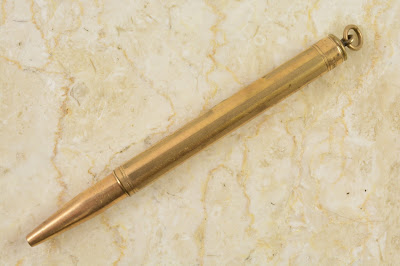This article has been edited and included in The Leadhead's Pencil Blog Volume 4; copies are available print on demand through Amazon here, and I offer an ebook version in pdf format at the Legendary Lead Company here.
If you don't want the book but you enjoy this article, please consider supporting the Blog project here.
After I won the auction online, I posted the seller’s picture in a discussion group and posed the question whether this was in fact purple and if so, whether it was unusual. When one person commented that it might just appear so because of a color imbalance (noting the almost glow-in-the-dark red pencils at the right in this picture), I used my rudimentary skills in post-production photography to crank the reds all the way down, and . . .
Still purple. When it arrived I snapped a quick cell phone picture and posted it in that same discussion group, to show that the color did appear to be purple – or maybe we should call it plum, with deference to the Parker 51's similarly elusive and difficult-to-spot hue. After one commenter said he thought it was just “plain old maroon,” I had to disagree. I set a maroon example next to it and shot this picture:
It clearly isn’t maroon, and since the nose and barrel are both made of the same material – bakelite – it can’t be material fading, either. No, call it Ishmael but don’t call it maroon.
What is interesting about these Autopoints is how they are truly transitional pieces, with one foot in the past and one hinting at what is to come. Pencils which came before had a metal tip to match the metal crown:
(And by the way, at the DC show I picked up one of these earlier models in what appears to be that same purplish color, shown here next to another maroon example:)
While the later ones had a plastic cap to match the bakelite nose:
Bob Bolin has studied Autopoints for years, and his website contains catalogs and a wealth of other information concerning the brand (Bolin is also responsible for publicizing Charles Keeran’s 1928 letter to Wahl’s directors detailing his version of the early history of Eversharp, for which historians will forever be in his debt). About these transitional models, Bolin says it is the “most rare oversize pencil known to exist” in the Autopoint line. In support of this statement, he refers to 1931 advertisements in Printers’ Ink which indicate that the bakelite tip replaced the metal one in March, 1931 (ad forwarded by Bob):
While the first advertisement showing the round plastic cap appeared in the September, 1931 edition (also forwarded to me by Bob):
While the date these improvements were introduced is fairly definite, both models remained in production for some time. Bob also forwarded to me a brochure, which he dates to 1936, in which both the plastic capped version was offered, as model 48:
And the metal capped version is also offered, as model 46:
The available colors for both models according to this brochure were maroon, green, red, blue, yellow or black, according to this brochure. Maybe there were other colors offered in other years, since several variants of the Model 48 have been shown here which don’t match any of those colors. Maybe what now looks purple was once more “blue.”
One thing which is fairly certain is that once Autopoint introduced its triangle-faceted “diamond cut” caps, the company discontinued both earlier variations of the Model 46 and Model 48. Autopoint regularly advertised in The Rotarian each month; issues through the September, 1937 issue show the round caps, while beginning with the October 1937 issue, advertisements show the new “diamond cut” cap. Here’s the ad from the November 1937 issue:
Note that the round upper ferrule and bolt-on clip, residual reminders of the Model 46 and 48, remain present in this picture. These features remain in Autopoint advertisements found in The Rotarian, which ran each month like clockwork until May, 1940. In June, the Autopoint advertisement didn’t show a picture of a pencil, and advertisements for the company were conspicuously absent from the July and August issues, but in the September, 1940 issue, the newly designed Model 48G is introduced:
That pinpoints the end of the bolted clips (on this series, anyway . . . they remained in use on the company’s double-ended pencils for much longer) to sometime between May and September, 1940.






















































